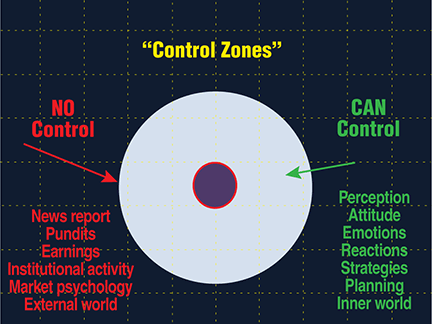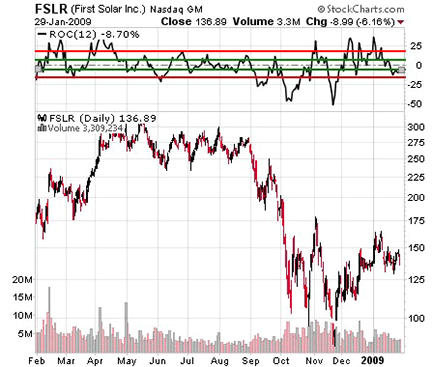AT THE CLOSE
Get In Sync With The Market
Do you know how you will react under specific circumstances? Do your emotions keep getting in the way?
Sometimes, the market is described as a living organism with a personality all its own. In an effort to understand this elusive quality, many traders rely on technical indicators to monitor and predict the state of the market. Others utilize models for measuring the microfundamentals of individual stocks or the macroaspects of economic trends. Experienced traders usually develop their own customized mix of indicators and/or fundamentals that works for them.
However, these same traders will often tell you that the indicators don’t always do what they’re supposed to do; that is, they don’t always cooperate.
Market activity
Despite our best efforts in calculating complex patterns, we still refer to market activity mainly in emotional terms:
- Abc stock soared on new product sales: Euphoria
- Investors stampeded for the exits on Xyz’s dismal earnings projection: Panic
- Pqr hit it out of the park with its new executive appointment: Cheering crowds; power; a winner!
- The hedge funds that shorted were crushed and shredded when the stock unexpectedly reversed: Annihilation, uncertainty, fear
The news media makes an attempt to put a brave face on the market’s behavior — a reason behind it. To hedge their bets, some Internet sites actually have two stories ready for print, one if it’s an up day, the other if it’s down. More often than not, the behavior is inexplicable.
Technicals and fundamentals are an essential part of any serious trader’s toolbox. They both provide valid, sophisticated information that describes market behavior and events. Yet for the trader, the picture is incomplete.
The missing piece of the picture is you, your personality, your psychology. What can make or break you as a trader are the reactions you have to unfolding market events. It’s not the market’s behavior, it’s your behavior that counts!
Real money = real emotions
If you have participated in simulated trading, you probably remember the big difference you felt when you first began to trade for real — pounding heart, dry mouth, sweating, cloudy thinking. Now multiply those emotions by millions of other traders and you get a sense of the complexity of psychological forces at work in the market.
Panic, depression, hysteria, euphoria — the entire emotional spectrum — all take on an intensity when your hard-earned money is on the line. These market emotions consequently can generate similar strong feelings in you and will cause you to react (that is, trade). If the market activity agrees with your perception, one set of positive emotions kicks in; conversely, if the unexpected occurs, negative feelings will take over.
How often have you had the experience of a long position inexplicably taking a nosedive after a great earnings report? Or a short position suddenly rising against you despite horrible economic news? How certain were you of your original decision in that moment? Did you know ahead of time how and to what degree you would feel positive/negative emotions? Based on that knowledge, did you have a plan of action that you could automatically and flawlessly execute?
Defining and optimizing your personal tolerances in areas such as risk (pain, euphoria) and the unexpected (change, volatility) can be a vital element for making better trading decisions. Usually, traders develop this understanding over a long period of time, sometimes after suffering significant losses through trial and error. However, with a good self-assessment, it is possible to avoid some of the pain and improve your chances for success.
Control yourself
Remember the commercial slogan, “Image is everything”? The market is no different. It constantly projects an emotional image that is being perceived by the media, fund managers, you, everyone. Based on these perceptions of everything from earnings, charts, the economy, politics, and the weather, decisions are made, bets are placed. All of this is outside your control or influence (Figure 1). And that’s the rub — lack of control. The most you think you can do is predict and react.

Figure 1: control zones
Actually, you can do much more. What you can have more control over is yourself.
To do this, you need to define the elements of your trading behavior. Integrating specific aspects of your behavior into the trader’s toolbox can add a powerful component to your arsenal.
All market environments are not suitable for all styles of traders. As you gain insight into your personal preferences for trading, instead of predicting and reacting, you can begin to synchronize your natural trading style with the conditions of the market. Synchronizing your unique profile to market conditions can inform you of when the market meets your criteria. It can also help you reduce errors and avoid unnecessary stress.
Tap into your psychological preferences
Great traders seem to be able to tap effortlessly into their highly developed, psychological instincts to produce outstanding trades. While all traders don’t have this talent naturally, an awareness and utilization of personal psychological strengths can be developed. If you define, quantify, and apply your optimal behaviors as they relate to factors such as change, decision-making, reward, and challenge, you gain a more objective and manageable sense of how you should approach the market.
For example, if you trade in highly volatile markets but find that you are not successful, you may be unaware or unrealistic about your psychological preferences in areas such as time frames or rate-of-change. Similarly, if you find yourself missing a large percentage of opportunities in slow-moving markets, it is likely that behavioral factors, such as pace-of-action, overanalysis, indecision, and procrastination are standing in your way.
Personalize your indicators
The red and green lines in Figure 2 are rate-of-change (Roc) indicator ranges. The parameters of the ranges, approximately 19 and 10, respectively, also represent two possible zones of risk tolerance. Based on behavioral preferences, the green trader will manifest stress behaviors upon entering the red area; similarly, the red trader can become complacent and inattentive if confined to the green area. So by identifying the character and intensity of your risk tolerance first, and then integrating it with a traditional indicator such as the Roc, you add a personal meaning to the indicator’s signals that are specific to you. The indicator would take on both a numerical and emotional significance.

Figure 2: risk tolerance zone. Here is an example of using the rate of change (ROC) indicator as a personal risk-tolerance “zone.”
Know yourself
Each of us has our own preferences in the way we like to be productive, efficient and comfortable. We rely on these behaviors to help us perform at our best and achieve our goals with confidence. The more time we are able to spend using our preferred behaviors, the better our performance.
Here is a suggested checklist of some behavioral areas that can help you assess and develop your trading style.
- Time frame: All of us have a trading attention span — daytrader, scalper, swing, or long term. Good traders will have sampled all types, but usually settle into one that works for them. If the way you perceive yourself is different from that of your true inner self, you can run into problems. For example, you might fancy yourself a daytrader, but if you’re continually making bad decisions, this time frame may not be your true preference.
- Risk tolerance: If you find yourself holding on to losing positions too long or selling winners too soon, it may be a sign that you are not managing stress well. Fear and greed are powerful emotions and many traders tend to become paralyzed, hence unable to see or act upon market conditions as they want to. Being aware of how you personally react to change will help you anticipate your reactions and better manage stress. Each of us has a comfort zone that, when defined and followed, will reduce errors that are based on stress.
- Decision-making: Some traders use an objective, detached style when making decisions, while others will have success utilizing emotional factors. Understanding how your mind prefers to make decisions can help you focus your talents with greater clarity. A stock that appears to be climbing a wall of worry might not fit the style of a logical decision-maker.
- Independence: Traders spend varying amounts of time on their own. There is a spectrum of preferred behaviors ranging from the ability to think independently to behaviors that require degrees of input from external sources.
- Pace: Some of us thrive in hectic environments, while others do better in a tranquil, quiet setting.
- Challenge: Active traders will often look upon the market as something to beat, a puzzle to be solved, a mystery to uncover. Understanding how much challenge you need in your life can guide you in selecting the types of markets you should trade.
- Reward: This component tells you what you prefer to receive as a result of your efforts. As a trader, your rewards would focus on the monetary. If, on the other hand, your preference is on social or people-oriented rewards, the drive for money would be secondary. In this case, your ability to concentrate on active trading might not be enough for success.
- Vision: Creative types have the ability to envision trends and patterns into the future, while implementers will have more of a focus on the details of the moment. One is not better than the other; both have their positives and weaknesses. Where do you fit in?
- Environment: Each of us has an environment that supports our most productive behavior. Do you prefer to work on your own or do you like interacting with people while working? This will give you an idea of what type of a trading setup you need to work in.
Putting it together
These behavioral components can be combined to produce a true trader profile based on your preferred ways of doing things. Learning to merge these preferences with the market’s personality can help you decide if conditions are favorable to your strengths or leading you into behavioral traps.
Great traders, whether they rely on technicals, fundamentals, or instincts, have one thing in common — a style. They have a sense of who they are, what they’re looking for, and how they will react to unfolding market events.
Take time to define and develop your own unique style, and it will set you on a fresh course for a more rewarding trading career.